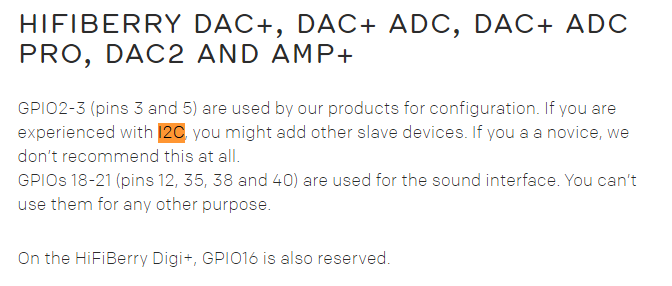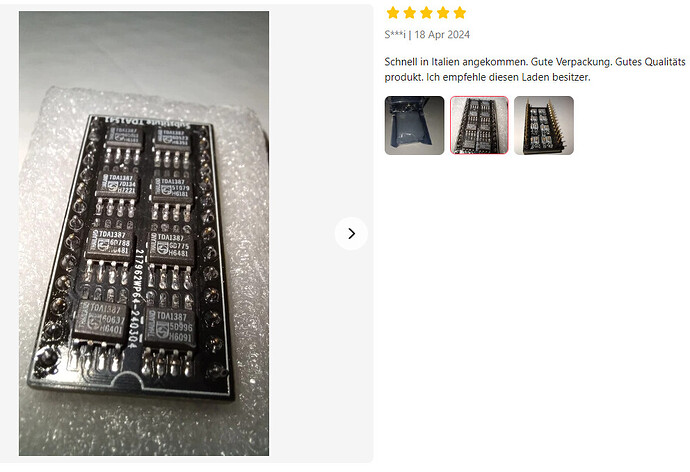welcome bressix.
basically all DAC boards for RPI will work on a Zero 2W.
Thanks for your reply.
Hey there Vincent, how do i get in contact with you, for the TDA1543 Module board
Please PM for the details. Still have a few left.
Thank you for your reply im currently new on this forum so i cant DM you, maybe you can DM me.
Thanks.
Sure. Please check PM.
Hello mr. Vincent I am also new in this forum and interested. Can you please DM me too.
All the best.
Branko.
Hi Vincent,
I can confirm your information.
All versions have the same signature.
The two new boards are slightly better than the old one.
So it was worth it. ![]()
The Gi version is indeed slightly darker and clearer.
With the TDA1543 it is indeed less loud and a bit less bass punch in our ears.
I bought two more TDA1387 daughter boards from alliexpress, but these sounds not exactly as your ones.
strange. So i would recommend to order them from you, because you already checked them.
We like the sound of your protodac boards very much.
regards.
Hi Jens,
Thanks very much for your feedback. Glad that you like them ![]()
I’m also glad that my observation was right - it took me some time to compare the different DAC at different time (morning, afternoon and night) with different mood and different health status before I could make a conclusion. I have the same feeling as yours and I also found that even if the volumes are set at the same levels, besides the bass punch, TDA1543 has less dynamics compared with TDA1387. It sounds like TDA1543 is flatter and softer in my ears.
Can I have the links to the TDA1387 daughter boards from AliExpress? Maybe I will order a couple of them and compare the difference in sound.
Hi Vincent,
i bought and tested these boards:
Testing a DAC at different times is a good aspect - thanks.
Hello there.
Can somebody tell what should I change to have my protoDAC start working? I have set I2S into HiFiBerry DAC+ pro…and got ALSA error.
Thanks Jens.
That’s really weird… they look like the same, should come from the same vendor I think…
Can you try the one without “+” or “pro”? ProtoDAC only needs I2S, I2C is not required. Actually ProtoDAC is supported by various drivers besides Hifiberry DAC.
Here is the screenshot from HifiBerry, I2C is needed by DAC+. That’s why you get an ALSA error.

Hi Vincent, do you offer a free downloadable
Gerber file and parts list or do you only sell a made up kit of your version?
Thanks
Hi Gis,
Sorry, I can provide the schematic but I don’t have the gerber for download. The schematic is rather simple, or you can download the gerber from Moode Audio.
Alternatively I have a few KITs and finished units for sale.
Hi Vincent
No problem, I would love to see the circuit and what changes you’ve made compared to the original one, which I’m already working on to do as a new PCB that makes it a bit easier to mount the resistors and large signal caps and bring in the 5v with a bit more distance from the audio output.
Additionally, have you considered a servo circuit to replace the expensive resistors and large caps? It’s unusual to still see those in the audio path and could potentially lower the cost of the unit even further and would reduce the variability of the sound based on availability of specific parts. Even with a top of the line opamp like an OPA1612 and a few resistors and caps it would be not just cheaper, but easier to source.
Theoretically this should be easy to do but I don’t have the right equipment to design and evaluate this properly.
Last request, would you consider dubbing your. Videos in English? Would love to watch those and understand what you are saying.
All the best and thank you for working on this amazing little project. I’m running 3 different versions of it and they are amazing.
Thanks, Gis
Hi Gis,
The changes are minimal, just added a power filtering, copper foil cap footprints and better grounding.
I don’t get the “servo circuit”. Would you please elaborate more?
Frankly speaking, I’m not confident to dub the videos in English as I’m not a native speakers. I think I have a strong accent which even if I speak English you won’t understand me. LOL. Maybe I can try later.
Enjoy the music ![]()
Forgot to mention, there are English subtitles on the videos.
The servo circuit that replaces the I/V (current-to-voltage) converter in the output of an audio circuit is commonly referred to as a DC servo circuit. This circuit is used to nullify DC offset in audio signals, thereby stabilizing the output and ensuring that only the AC audio signal passes through.
Overview of DC Servo Circuit
A DC servo circuit is typically an op-amp-based circuit that senses the DC offset at the output of an audio amplifier and applies a corrective voltage to the input to cancel out the offset. This helps in maintaining a zero DC output,
I look forward to seeing the video with the subtitles!
Thanks
Gis
Hi Gis,
Thanks for your explanation. Now I get it.
Frankly speaking I’m not a fan of op-amps. I’d prefer simple stuff. Actually output transformers can accept a small amount of DC without saturating the magnetic flux, the circuits of coupling caps and output transformers are much simpler, and caps and output transformers can smoothen the sound as well.
Thanks for watching my videos, I’ll share my finding of output transforms with TDA1541(A).

